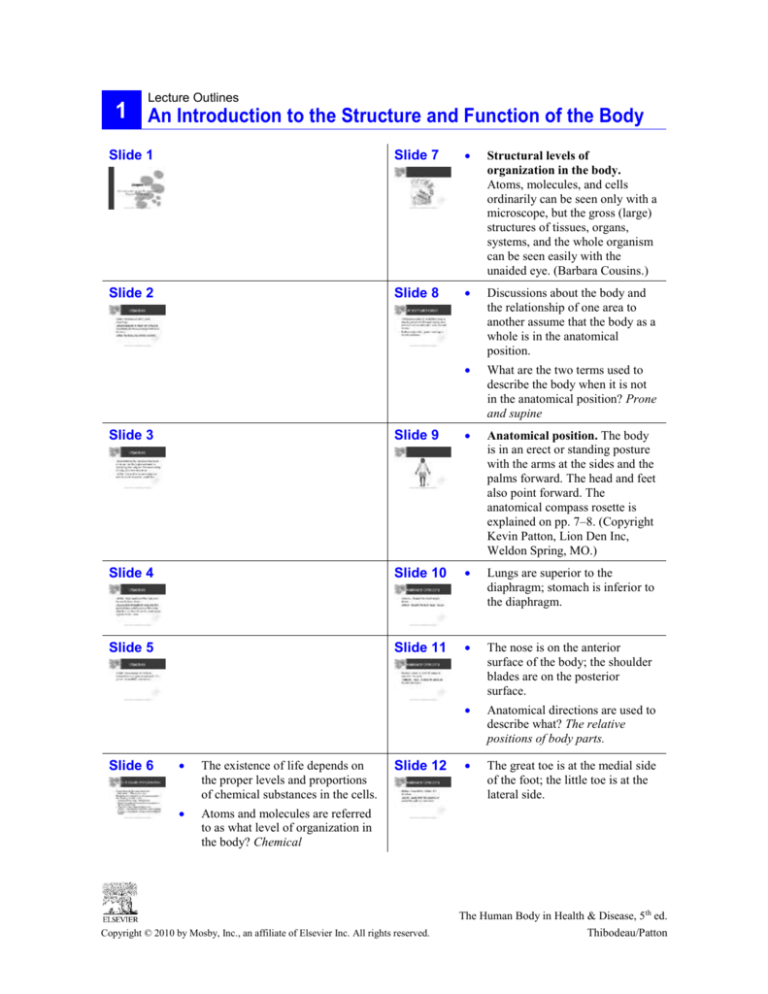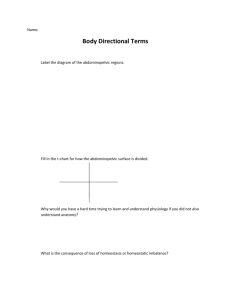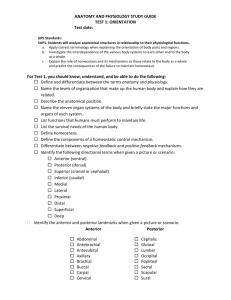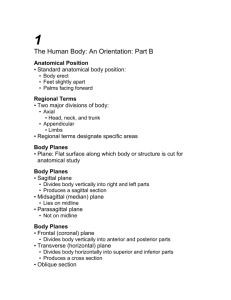
Lecture Outlines
1 An Introduction to the Structure and Function of the Body
Slide 1
Slide 7
Structural levels of
organization in the body.
Atoms, molecules, and cells
ordinarily can be seen only with a
microscope, but the gross (large)
structures of tissues, organs,
systems, and the whole organism
can be seen easily with the
unaided eye. (Barbara Cousins.)
Slide 2
Slide 8
Discussions about the body and
the relationship of one area to
another assume that the body as a
whole is in the anatomical
position.
What are the two terms used to
describe the body when it is not
in the anatomical position? Prone
and supine
Slide 3
Slide 9
Anatomical position. The body
is in an erect or standing posture
with the arms at the sides and the
palms forward. The head and feet
also point forward. The
anatomical compass rosette is
explained on pp. 7–8. (Copyright
Kevin Patton, Lion Den Inc,
Weldon Spring, MO.)
Slide 4
Slide 10
Lungs are superior to the
diaphragm; stomach is inferior to
the diaphragm.
Slide 5
Slide 11
The nose is on the anterior
surface of the body; the shoulder
blades are on the posterior
surface.
Anatomical directions are used to
describe what? The relative
positions of body parts.
The great toe is at the medial side
of the foot; the little toe is at the
lateral side.
Slide 6
The existence of life depends on
the proper levels and proportions
of chemical substances in the cells.
Atoms and molecules are referred
to as what level of organization in
the body? Chemical
Slide 12
The Human Body in Health & Disease, 5th ed.
Copyright © 2010 by Mosby, Inc., an affiliate of Elsevier Inc. All rights reserved.
Thibodeau/Patton
14
Chapter 1 An Introduction to the Structure and Function of the Body __________________________
Slide 13
The elbow lies at the proximal end
of the lower arm; the hand lies at
the distal end.
Slide 18
Body cavities. Location and
subdivisions of the dorsal and
ventral body cavities as viewed
from the front (anterior) and from
the side (lateral). (Rolin Graphics.)
Slide 14
The skin of the arm is superficial to
the muscles; the bone of the upper
arm is deep to the muscles that
surround it.
Slide 19
Which organ separates the
thoracic cavity from the
abdominal cavity? Diaphragm
Why are the anatomical positions
listed in pairs? It is easier to learn
them.
In which cavity is the
mediastinum located? The
mediastinum is located in the
ventral body cavity.
Which plane divides the body into
two equal halves? Midsagittal
plane
Which plane runs lengthwise from
side to side and divides the body
into the front and back? Frontal
plane
Division of the abdominopelvic
cavity into four quadrants.
Diagram showing relationship of
internal organs to the four
abdominal quadrants. (Barbara
Cousins.)
The nine regions of the
abdominopelvic cavity. The
most superficial organs are
shown. Look at Figure 1-7
(p. 10); can you identify the
deeper structures in each region?
(Barbara Cousins.)
Name some of the regions of the
upper extremity and lower
extremity. Upper: facial, frontal,
cervical; lower: femoral, pedal,
tarsal
Slide 15
Slide 20
Slide 16
Directions and plans of the body.
(Barbara Cousins.)
Slide 21
Slide 17
The body is made up of cavities
that contain compact, well-ordered
arrangements of internal organs.
Slide 22
The two major body cavities are
the ventral and dorsal body
cavities.
The subdivisions of the ventral
body cavity are thoracic (chest)
cavity, pleural (lungs) cavity,
mediastinum, diaphragm,
abdominal cavity, abdominopelvic
cavity, and pelvic cavity.
The subdivisions of the dorsal
cavity are the cranial cavity and
spinal cavity.
The Human Body in Health & Disease, 5th ed.
Copyright © 2010 by Mosby, Inc., an affiliate of Elsevier Inc. All rights reserved.
Thibodeau/Patton
________________________ Chapter 1 An Introduction to the Structure and Function of the Body
15
Slide 23
Axial and appendicular divisions
of the body. Specific body regions
are labeled.
Slide 25
Negative feedback loops. A, An
engineer’s diagram showing how
relatively constant room
temperature (controlled
condition) can be maintained.
A thermostat (control center)
receives feedback information
from a thermometer (sensor) and
responds by counteracting change
from normal by activating a
furnace (effector). B, A
physiologist’s diagram showing
how a relatively constant body
temperature (controlled
condition) can be maintained. The
brain (control center) receives
feedback information from nerve
endings called cold receptors
(sensors) and responds by
counteracting a change from
normal by activating shivering by
muscles (effectors).
Slide 24
Name some examples of negative
feedback loops. Muscles shiver to
raise body temperature.
Slide 26
Name some examples of positive
feedback loops. Uterine
contractions during the birth of a
baby; to stop bleeding, platelets
cluster to form a blood clot
Does homeostasis maintain
absolutely constant values?
Homeostasis is a balance or
relative constancy in an
organism.
Define developmental processes
and aging processes. During
childhood, homeostatic functions
gradually become more efficient
and effective. During late
adulthood and old age, they
become less efficient and
effective.
How does negative feedback differ
from positive feedback? Negative
feedback loops oppose or negate a
change in the body, whereas
positive feedback loops
temporarily amplify the change
that is occurring.
The Human Body in Health & Disease, 5th ed.
Copyright © 2010 by Mosby, Inc., an affiliate of Elsevier Inc. All rights reserved.
Thibodeau/Patton









